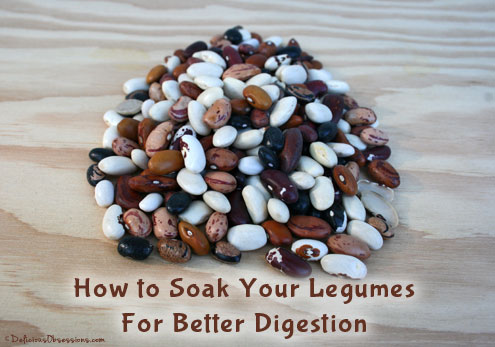FTC Disclosure: Delicious Obsessions may receive comissions from purchases made through links in this article. As an Amazon Associate I earn from qualifying purchases.Read our full terms and conditions here.
The importance of soaking certain foods cannot be emphasized enough. In the past, I have written about soaking your grains and soaking your nuts and seeds. Now, it’s time to talk about soaking your legumes.
I think most people are familiar with the need to soak your dried beans. But, what they might not know is why it is important to prepare legumes in a certain way. Soaking your beans before cooking is something that has been handed down to us by traditional cultures. Legumes, also called pulses, have been feeding and nourishing humans for centuries. They are a great source of nutrition, especially in regions where other protein sources are scarce. Beans are a staple in some cultures’ diets. They are cheap, filling, last a long time, and packed full of nutrition.
The legume family includes beans, chickpeas, lentils, peas, peanuts, soybeans, and cashews. Soybeans should not be consumed unless they have been fermented. Unfermented soy products are toxic and should be avoided. You can read more about the dangers of soy here and here.
Legumes are rich in protein and fiber. They are also a great source of various minerals and B vitamins. Research has show that they might contain anti-cancer properties. All legumes contain omega-3s and omega-6s. Depending on the type of bean, amounts will vary.
Beans have traditionally be soaked for very long periods of time before they are cooked. They are typically soaked, then drained, then rinsed, then perhaps soaked again, depending on the variety. Once you cook the beans, pay special attention to skim off any foam that rises to the surface. This foam contains impurities that should not be consumed. Sometimes, it is suggested that the water be changed halfway through cooking.
By taking the time to properly prepare legumes, we can ensure that they are digestible, which is probably the number one concern when consuming beans — intestinal discomfort. The process of soaking and cooking will neutralize the enzyme inhibitors and phytic acid that are in legumes. It also helps break down the complex sugars, which are the cause of the indigestion we have all experienced with beans.
When it comes down to it, soaking and preparing dried beans is not hard. It just takes a little bit of advanced planning and you’re good to go. Just follow these general guidelines:
- 6-8 hours soaking time / 1-3 hours cooking time: lentils
- 12-24 hours soaking time / 4-8 hours cooking time: black, kidney, pinto, white, or black-eyed peas
- 24 hours soaking time / 6-8 hours cooking time: chickpeas
NOTE: You may need to adjust the cooking times based on your elevation. I live in Denver, and if I am cooking legumes they take a LOOOOOOOOOOOOOOOOONG time unless I use a pressure cooker. It takes at least twice and sometimes three times as long here than at sea level.
Sally Fallon’s Basic Lentil Recipe (NT, pg. 507)
2 cups lentils, soaked
warm filtered water
2 tbsp. whey or lemon juice
3 cups beef or chicken broth (homemade is best)
2 cloves garlic, peeled and crushed
fresh thyme sprigs
1 tsp. dried peppercorns, crushed
pinch of dried chile flakes (optional)
1 teaspoon sea salt
juice of 1-2 lemons
Cover lentils with warm water. Stir in whey or lemon juice. Cover and leave in a warm place for 6-8 hours. Drain, rinse, and place in a large pot with the stock. Bring to a boil and skim off any foam that rises to the top. Add the garlic, thyme, peppercorns, and chile flakes. Simmer uncovered for about 1 hour or until the liquid has reduced. Stir occasionally to prevent burning. Add the lemon juiced and season to taste.
Sally Fallon’s Basic Bean Recipe (NT, pg. 496)
2 cups beans (black, kidney, pinto, white, or black-eyed peas)
warm filtered water
2 tablespoons of whey or lemon juice
4 cloves of garlic, peeled and mashed
sea salt and pepper
Cover the beans in warm water. Stir in the whey or lemon juice and leave in a warm place for 12-24 hours, depending on the size of the bean. Drain, rinse, and place beans in a large pot and cover with water. Bring the beans to a boil and skim off any foam that rises to the top. Reduce the heat and add garlic. Summer, covered, for 4-8 hours. Make sure you check occasionally for water and add moire as needed.
Sally Fallon’s Basic Chickpea Recipe (NT, pg. 505)
1 cup dried chickpeas
warm filtered water
2 tbsp. whey or lemon juice
1 tsp. sea salt
Cover the chickpeas with warm water and stir in whey or lemon juice. Leave, covered, in a warm spot for 24 hours. Drain the chickpeas and remove the skins. Transfer to a large pot and add salt and water to cover. Bring to a boil, skimming any foam that rises. Cover and simmer 6 hours or until very tender. Drain. Best used in salads.


14 Comments